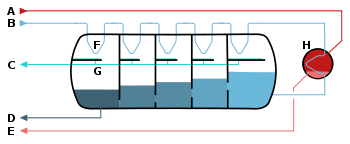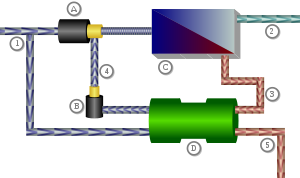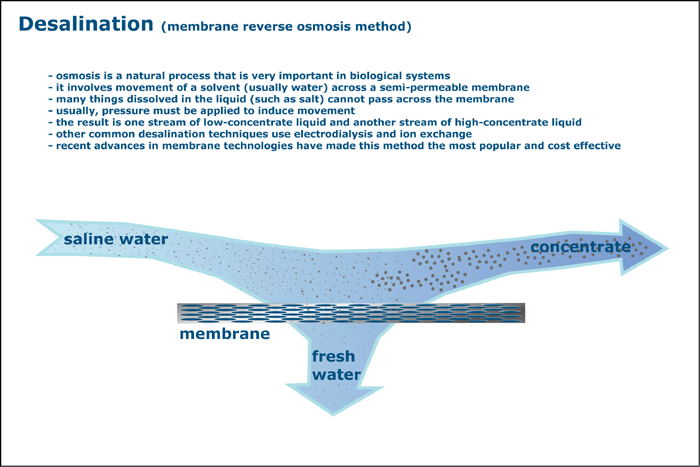Introduction
Our world is embracing for years of unreliable climate, with the areas known for natural supply of fresh waters getting increasingly affected. Increasing salinity of water, pose unimaginable health associated risks to the society today. Climatic change that has been encroaching our world is fast approaching with its repercussions such as global warming, acidification of the oceans and severe weather, among others taking shape. Of great interest is severe weather and acidification of oceanic waters that pose great danger to both man and aquatic life. To combat this, various governments and companies as well as individuals are increasingly getting involved in desalination of seawater, and salty waters, to make them safe for human consumption. This paper will try to explore how salty water is desalinated into fresh drinkable water (Fischetti, 2007, p. 118-119).
Process
The main objective of such processes is to convert salty water into one that is suitable for human use or in some cases for irrigation purposes. Several Large ships have been used in desalination of seawater, sometimes in small-scale and at times in large-scale. The focus is on areas that receive less rainfall and consequently need effective ways of desalinating salty waters for use. There are several processes used in this regard, among which are, distillation, ion exchange, the membrane process, Nanofiltration, Geothermal, solar, green house for seawater, and methane hydrate method of crystallization, others include Reverse osmosis, and electrodialysis, among others. The most widely used of these methods, throughout the world, are distillation and reverse osmosis (Fischetti, 2007, p. 118-119).
Machine
The most widely used distillation method is the multi-stage flash method of distillation, which is mainly rivaled by the membrane process known as reverse osmosis. The figures below show the processes of the two desalination processes mentioned above.

- A – Steam in
- B – Seawater in
- C – Potable water out
- D – Waste out
- E – Steam out
- F – Heat exchange
- G – Condensation collection
- H – Brine heater

- 1:Sea water inflow,
- 2: Fresh water flow (40%),
- 3:Concentrate Flow (60%),
- 4:Sea water flow (60%),
- 5: Concentrate (drain),
- A: High pressure pump flow (40%),
- B: Circulation pump,
- C:Osmosis unit with membrane,
- D: Pressure exchanger
Object
To explore how desalination plant converts salty water into fresh water, ready for human use. To determine weather it is feasible (Eckhardt, 2010, p. 1).
Theory
Due to the ever-increasing unreliability of rainwater and other known fresh water supply regions such as rivers, lakes and the likes, the world has been drawn into processing salty waters for fresh, ready to drink water, by the process of desalination. This process involves the removal of salt from water, and aims to make it consumable to human. Desalination started thousands of years ago, when sailors used the sun’s solar radiation to separate salt from water. Distillation, although very expensive, has been used widely throughout the world, including electrodialysis method. In recent times, a cheaper method of desalination, known as membrane separation has received much applause as a viable method. Plans are also underway to desalinate the less salty groundwater than seawater, mainly for economic purposes (Outokumpu, 2011, p. 1).
Membrane process has come out as the most cost-effective method of desalination. The demand for potable water has necessitated need to sustain it with fresh water. Regions where fresh water sources are fragile and unreliable are the worst affected areas; moreover, climatic change poses a great threat to the formerly consistent water supply areas. Population increase being another factor, rapidly exploits the already depleted fresh water sources, this has prompted governments and companies to resort to desalination. Several countries, including the United States, Australia and China are now desalinating public supply to curb the increasing demand for potable water (Outokumpu, 2011, p. 1).
Concept
The once reliable water sources are increasingly facing depletion, prompting governments to opt for the more expensive desalination process. There are many processes of water desalination, among which are distillation and membrane separation process. Distillation was widely used until considerable developments were made on membrane separation, which applies filtration process. Filtration between the membranes is therefore used to separate salt from water, thereby getting fresh water (Eckhardt, 2010, p. 1).
Technical explanation

Desalination of salty water has been on the rise as demand for potable water supply swells, the population surges and climatic changes effect depletion on reliable sources. Several processes can be used in desalination, among which include distillation and filtration. The method considered in this paper and of great interest for its emerging use is the reverse osmosis plant. This method uses membrane to separate salty concentrated solutions from fresh water. It is more viable and cheaper to construct compared to distillation method like, multi-stage flash desalination plant (Eckhardt, 2010, p. 1).
Reverse osmosis method, which is similar to osmosis process in biological systems, involves the movement of solvent water molecules across the semi-permeable membrane. When salty water try to pass across the membrane, usually through application of pressure, only fresh water is allowed to pass, while the more concentrated solution continues as shown in figure 3 above. Fresh water is then collected and supplied for consumption (Pascoe, 2011, p. 1).
Summary
Desalination is the process of separating salt from water. Several processes have been employed for this purpose. They include distillation and filtration, among others. These methods are expensive and are only applicable when there is no alternative source of fresh water. However, due to the increasing demand of potable water as the rapidly surging population takes shape and the once dependable sources gets depleted due to climatic changes, governments and companies are forced to ponder other alternatives like desalination. Distillation was the most widely used of these methods; nonetheless, the membrane separation has overtaken distillation since it is more viable and cheaper. Reverse osmosis method helps in separation of salt from water through a semi-permeable membrane (Pascoe, 2011, p. 1).
Conclusion
Desalination is the process of acquiring fresh water from salty water by separation. It involves different processes, which include distillation, and filtration, among others. Reverse osmosis, a form of filtration through osmosis is the most viable and can be used in converting salty water into fresh potable water (Heimbuch, 2010, p. 1).
Reference List
Eckhardt, G., 2010. Desalination. The Edwards Aquifer Website. Web.
Fischetti, M., 2007. “Fresh from the Sea”. Scientific American. 297 (3): 118–119. Web.
Heimbuch, J., 2010. Desalination Plant Helps Save a California Coastal Community. Planetgreen. Web.
Outokumpu., 2011. Process and Resources. Outokumpu. Web.
Pascoe M., 2011. Desalination. International Water Centre Pty ltd. Brisbane. Web.